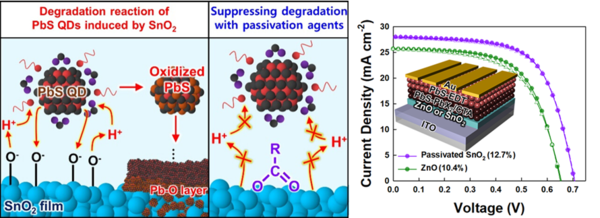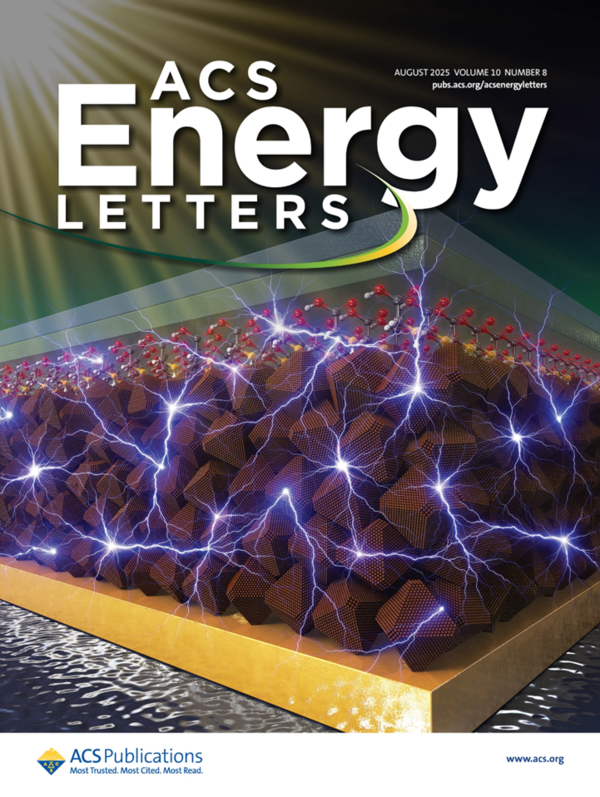Selected as a cover article in「ACS Energy Letters」.

On August 18, the joint research team led by Professor Ko Min-jae at Hanyang University and Dr. Yu Hyeong-geun at the Korea Institute of Science and Technology (KIST) announced that they have overcome performance limitations by applying a surface treatment technique to inexpensive tin dioxide (SnO₂) materials, achieving a world-leading power conversion efficiency (PCE) for lead sulfide (PbS) quantum dot solar cells.
Quantum dots are semiconductor crystals just a few nanometers in size, with optoelectronic properties that can be freely tuned depending on their particle size. Especially, PbS quantum dots can absorb and emit light into the infrared region, and thus are promising for next-generation optoelectronic devices such as solar cells, infrared cameras and night vision goggles, optical communication modules and LiDAR systems, and medical or bio-imaging equipment. In these devices, the efficiency of the electron transport layer—which collects and moves electrons generated by light—is a critical factor.
While tin dioxide offers high transparency and electrical conductivity and has attracted attention as an electron transport layer material, its performance in quantum dot devices has been lower than that of zinc oxide (ZnO), leading to limited application. The 페스타토토 team identified that such limit originated from 'interfacial degradation reactions,' particularly from the emission of protons (H⁺) from the SnO₂ surface, which leads to the removal of quantum dot surface ligands and the oxidation of lead.

To address this, the 페스타토토ers employed a 'surface passivation' technique, treating the SnO₂ surface with molecules possessing both carboxyl(-COOH) and thiol(-SH) groups. This suppressed unwanted reactions and improved charge extraction efficiency, resulting in a solar cell power conversion efficiency of 12.7%, greatly surpassing conventional ZnO-based devices (10.4%). In addition, the device demonstrated excellent stability, retaining 90% of its initial efficiency for over 100 days even without encapsulation.
Professor Ko Min-jae stated, “This research holds great significance in that it enables high-performance quantum dot devices using inexpensive tin dioxide, laying the foundation for wide application in perovskite and organic solar cells, as well as quantum dot-based infrared sensors, optical communication modules, and LiDAR systems.”

This 페스타토토 was supported by the National 페스타토토 Foundation of Korea, and the results were published as the cover article in ACS Energy Letters(impact factor 18.2) in the August 8, 2025 issue. The paper, 'Suppressing Interfacial Deprotonation of Metal Oxides for Efficient PbS Quantum Dot Photovoltaics,' lists Kim Woo-yeon from Hanyang University and Lim Chan-woo from KIST as co-first authors, with Professor Ko Min-jae (Hanyang University) and Dr. Yu Hyeong-geun (KIST) as corresponding authors.
관련페스타토토
- Sculpting Light: Professor Ko Min-jae’s Innovation in Perovskite Nanocrystals
- The National Academy of 토토사이트 은행 조회 of Korea Announces New Members for 2025...Seven 토토사이트 은행 조회 Professors Included
- Seeking Dramatic Improvement of Battery Lifespan and Safety via Multidimensional Current Collector 토토사이트 바코드 for 토토사이트 바코드 Metal 토토사이트 바코드
- Five Graduate Students from HYU Professor Ko Min-jae’s 그랜드토토 Team Simultaneously Selected for NRF Fellowship, Proving Competence of Student < 성과

 '한양위키' 키워드 보기
'한양위키' 키워드 보기